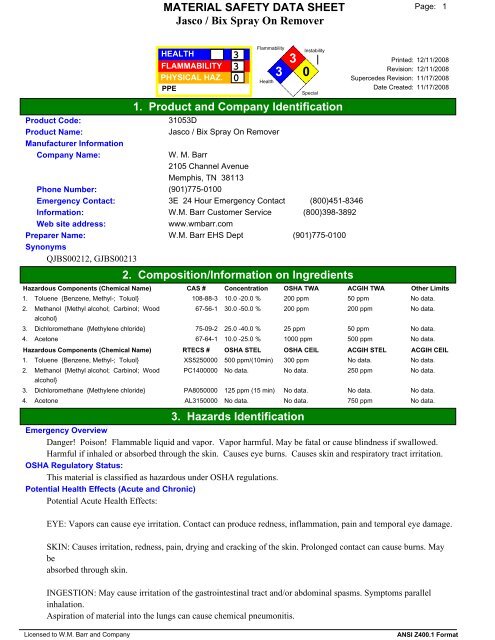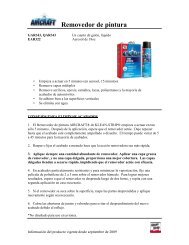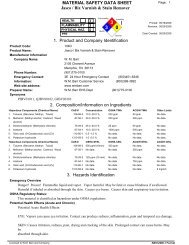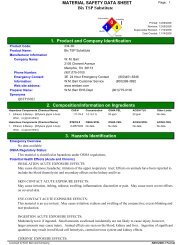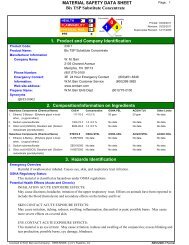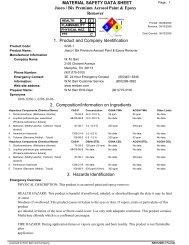Jasco / Bix Spray On Remover MATERIAL SAFETY DATA ... - WM Barr
Jasco / Bix Spray On Remover MATERIAL SAFETY DATA ... - WM Barr
Jasco / Bix Spray On Remover MATERIAL SAFETY DATA ... - WM Barr
You also want an ePaper? Increase the reach of your titles
YUMPU automatically turns print PDFs into web optimized ePapers that Google loves.
<strong>MATERIAL</strong> <strong>SAFETY</strong> <strong>DATA</strong> SHEET<br />
<strong>Jasco</strong> / <strong>Bix</strong> <strong>Spray</strong> <strong>On</strong> <strong>Remover</strong><br />
HEALTH 3<br />
FLAMMABILITY<br />
PHYSICAL HAZ.<br />
3<br />
PPE<br />
0<br />
Flammability<br />
Health<br />
3<br />
3<br />
Instability<br />
0<br />
Special<br />
1. Product and Company Identification<br />
Product Code: 31053D<br />
Product Name:<br />
Manufacturer Information<br />
<strong>Jasco</strong> / <strong>Bix</strong> <strong>Spray</strong> <strong>On</strong> <strong>Remover</strong><br />
Company Name: W. M. <strong>Barr</strong><br />
2105 Channel Avenue<br />
Memphis, TN 38113<br />
Phone Number: (901)775-0100<br />
Emergency Contact: 3E 24 Hour Emergency Contact (800)451-8346<br />
Information: W.M. <strong>Barr</strong> Customer Service (800)398-3892<br />
Web site address: www.wmbarr.com<br />
Preparer Name:<br />
Synonyms<br />
QJBS00212, GJBS00213<br />
W.M. <strong>Barr</strong> EHS Dept (901)775-0100<br />
2. Composition/Information on Ingredients<br />
Page:<br />
1<br />
Printed: 12/11/2008<br />
Revision: 12/11/2008<br />
Supercedes Revision: 11/17/2008<br />
Date Created: 11/17/2008<br />
Hazardous Components (Chemical Name)<br />
CAS # Concentration OSHA TWA ACGIH TWA Other Limits<br />
1. Toluene {Benzene, Methyl-; Toluol} 108-88-3 10.0 -20.0 % 200 ppm 50 ppm<br />
No data.<br />
2. Methanol {Methyl alcohol; Carbinol; Wood<br />
alcohol}<br />
67-56-1 30.0 -50.0 % 200 ppm 200 ppm<br />
No data.<br />
3. Dichloromethane {Methylene chloride} 75-09-2 25.0 -40.0 % 25 ppm 50 ppm<br />
No data.<br />
4. Acetone 67-64-1 10.0 -25.0 % 1000 ppm 500 ppm<br />
No data.<br />
Hazardous Components (Chemical Name) RTECS # OSHA STEL OSHA CEIL ACGIH STEL ACGIH CEIL<br />
1. Toluene {Benzene, Methyl-; Toluol} XS5250000 500 ppm/(10min) 300 ppm No data.<br />
No data.<br />
2. Methanol {Methyl alcohol; Carbinol; Wood<br />
alcohol}<br />
PC1400000 No data.<br />
No data. 250 ppm<br />
No data.<br />
3.<br />
4.<br />
Dichloromethane {Methylene chloride} PA8050000 125 ppm (15 min)<br />
Acetone AL3150000 No data.<br />
3. Hazards Identification<br />
No data. No data.<br />
No data.<br />
No data. 750 ppm<br />
No data.<br />
Emergency Overview<br />
Danger! Poison! Flammable liquid and vapor. Vapor harmful. May be fatal or cause blindness if swallowed.<br />
Harmful if inhaled or absorbed through the skin. Causes eye burns. Causes skin and respiratory tract irritation.<br />
OSHA Regulatory Status:<br />
This material is classified as hazardous under OSHA regulations.<br />
Potential Health Effects (Acute and Chronic)<br />
Potential Acute Health Effects:<br />
EYE: Vapors can cause eye irritation. Contact can produce redness, inflammation, pain and temporal eye damage.<br />
SKIN: Causes irritation, redness, pain, drying and cracking of the skin. Prolonged contact can cause burns. May<br />
be<br />
absorbed through skin.<br />
INGESTION: May cause irritation of the gastrointestinal tract and/or abdominal spasms. Symptoms parallel<br />
inhalation.<br />
Aspiration of material into the lungs can cause chemical pneumonitis.<br />
Licensed to W.M. <strong>Barr</strong> and Company ANSI Z400.1 Format
<strong>MATERIAL</strong> <strong>SAFETY</strong> <strong>DATA</strong> SHEET<br />
<strong>Jasco</strong> / <strong>Bix</strong> <strong>Spray</strong> <strong>On</strong> <strong>Remover</strong><br />
Page:<br />
Printed: 12/11/2008<br />
Revision: 12/11/2008<br />
Supercedes Revision: 11/17/2008<br />
INHALATION: Causes irritation to the respiratory tract. Causes formation of carbon monoxide in blood which<br />
affects<br />
cardiovascular system and central nervous symptoms. Symptoms of overexposure may include skin sensations<br />
(e.g.<br />
pins and needles), fatigue, confusion, headaches, dizziness and drowsiness. Very high concentrations or continued<br />
exposure may cause increased light-headedness, vomiting, blurred vision, blindness, staggering, unconsciousness,<br />
comas, and even death.<br />
CHRONIC EXPOSURE: Methylene Chloride may cause headache, mental confusion, depression, liver effects,<br />
kidney<br />
effects, bronchitis, loss of appetite, nausea, lack of balance, and visual disturbances. Prolonged and/or repeated<br />
skin<br />
contact can cause severe irritation or dermatitis. Methylene chloride may cause cancer in humans. Toluene may<br />
affect<br />
the developing fetus. Toluene chronic poisoning describe anemia, decreased blood cell count and bone marrow<br />
hypoplasia. Methanol report impaired vision.<br />
Target Organs: eyes, skin, respiratory system, liver, kidneys, pancreas, heart, lungs, brain, central nervous system<br />
Signs and Symptoms Of Exposure<br />
See Potential Health Effects.<br />
Medical Conditions Generally Aggravated By Exposure<br />
Those of the skin, eye, and lungs/respiratory system. This may include dermatitis; asthma and other breathing<br />
disorders; chronic lung disease; coronary artery disease; anemia;<br />
4. First Aid Measures<br />
Emergency and First Aid Procedures<br />
INHALATION: If inhaled, remove to fresh air. If not breathing, give artificial respiration. If breathing is difficult,<br />
give<br />
oxygen and seek medical attention immediately.<br />
SKIN: Immediately wash with mild soap and water for 15 minutes, while removing contaminated clothing and<br />
shoes.<br />
Wash clothing before reuse. Get medical attention.<br />
EYE: Immediately flush with water for at least 15 minutes, lifting lower and upper eyelids occasionally. Get<br />
medical<br />
attention immediately.<br />
INGESTION: Aspiration hazard. Do not take internally. If swallowed, DO NOT INDUCE VOMITING. Give<br />
large<br />
quantities of water. Never give anything by mouth to an unconscious person. Get medical attention immediately.<br />
If<br />
vomiting occurs, keep head below hips to prevent aspiration into lungs.<br />
Note to Physician<br />
This product contains methanol which can cause intoxication and central nervous system depression. Methanol is<br />
metabolized to formic acid and formaldehyde. These metabolites can cause metabolic acidosis, visual<br />
disturbances and blindness. Since metabolism is required for these toxic symptoms, their onset may be delayed<br />
from 6 to 30 hours following ingestion. Ethanol competes for the same metabolic pathway and has been used to<br />
prevent methanol metabolism. Ethanol administration is indicated in symptomatic patients or at blood methanol<br />
Licensed to W.M. <strong>Barr</strong> and Company ANSI Z400.1 Format<br />
2
<strong>MATERIAL</strong> <strong>SAFETY</strong> <strong>DATA</strong> SHEET<br />
<strong>Jasco</strong> / <strong>Bix</strong> <strong>Spray</strong> <strong>On</strong> <strong>Remover</strong><br />
concentrations above 20 ug/dl. Methanol is effectively removed by hemodialysis.<br />
5. Fire Fighting Measures<br />
Page:<br />
Printed: 12/11/2008<br />
Revision: 12/11/2008<br />
Supercedes Revision: 11/17/2008<br />
Flammability Classification: IB<br />
Flash Pt: 48.00 F Method Used: Pensky-Marten Closed Cup<br />
Explosive Limits: LEL: No data. UEL: No data.<br />
Fire Fighting Instructions<br />
Evacuate personnel to a safe area. Keep containers cool with water spray.<br />
Avoid breathing decomposition products. Firefighters should wear NIOSH approved self-contained breathing<br />
apparatus<br />
and full body protection. Vapors can flow along surfaces to distant ignition source and flash back.<br />
Flammable Properties and Hazards<br />
Flammable Liquid and Vapor!<br />
Dangerous fire hazard when exposed to heat or flame. Vapors can flow along surfaces to distant ignition source<br />
and flash back.<br />
Hazardous Combustion Products<br />
Carbon monoxide and carbon dioxide, hydrogen chloride, and trace amounts of phosgene, chlorine.<br />
Extinguishing Media<br />
Use alcohol foam, carbon dioxide, and dry chemical. Water may be used to flush spills away from exposures and<br />
to dilute spills to non-flammable mixtures.<br />
Unsuitable Extinguishing Media<br />
None known.<br />
6. Accidental Release Measures<br />
Steps To Be Taken In Case Material Is Released Or Spilled<br />
Ventillate area of leak or spill. Remove all sources of ignition. Use non-sparking tools and equipment. Clean up<br />
remaining materials from spill with suitable absorbent. Small spills may be absorbed with nonreactive absorbent<br />
(sand) and placed in suitable, covered, labeled containers. For large spills provide diking or other appropriate<br />
containment to keep material from spreading. Prevent large spills from entering sewers or waterways. If diked<br />
material can be pumped, store recovered material in compatible drums for recovery or disposal. Observe all<br />
personal protection equipment recommendations.<br />
7. Handling and Storage<br />
Precautions To Be Taken in Handling<br />
No smoking or eating. Keep container closed when not in use. Keep away from heat, sparks, open flames and<br />
other sources of ignition. Containers of this material may be hazardous when empty since they retain product<br />
residues. Separate from incompatibles. This material may corrode plastic and rubber. KEEP OUT OF REACH OF<br />
CHILDREN.<br />
Precautions To Be Taken in Storing<br />
Store in a cool, dry well-ventilated location. Protect against physical damage.<br />
8. Exposure Controls/Personal Protection<br />
Respiratory Equipment (Specify Type)<br />
Avoid breathing vapor. Use NIOSH approved pressure demand or other positive pressure SCBA or airline<br />
respirators.<br />
Eye Protection<br />
Use chemical goggles or glasses with side shields. A faceshield in combination with safety glasses or chemical<br />
goggles is recommended when the potential exists for spraying or splashing of liquid to the face.<br />
Protective Gloves<br />
Use chemical resistant gloves based on chemical compatibility and job task.<br />
Licensed to W.M. <strong>Barr</strong> and Company ANSI Z400.1 Format<br />
3
<strong>MATERIAL</strong> <strong>SAFETY</strong> <strong>DATA</strong> SHEET<br />
<strong>Jasco</strong> / <strong>Bix</strong> <strong>Spray</strong> <strong>On</strong> <strong>Remover</strong><br />
Page:<br />
Printed: 12/11/2008<br />
Revision: 12/11/2008<br />
Supercedes Revision: 11/17/2008<br />
Other Protective Clothing<br />
Full Protective Clothing.<br />
Various application methods can dictate use of additional protective safety equipment, such as impermeable<br />
aprons, etc., to minimize exposure.<br />
Engineering Controls (Ventilation etc.)<br />
Use process enclosures, local exhaust ventilation, or other engineering controls to control airborne levels below<br />
recommended exposure limits.<br />
Use only with adequate ventilation to prevent buildup of vapors. Do not use in areas where vapors can accumulate<br />
and concentrate, such as basements, bathrooms or small enclosed areas. Whenever possible, use outdoors in an<br />
open air area. If using indoors open all windows and doors and maintain a cross ventilation of moving fresh air<br />
across the work area. If strong odor is noticed or you experience slight dizziness, headache, nausea or<br />
eye-watering -- STOP -- ventilation is inadequate. Leave area immediately and move to fresh air.<br />
Work/Hygienic/Maintenance Practices<br />
Have an eyewash and safety shower available.<br />
The usual precaution for the handling of chemicals must be observed.<br />
Wash hands thoroughly after use and before eating, drinking, or smoking. Do not eat, drink, or smoke in the<br />
work area. Discard any clothing or other protective equipment that cannot be decontaminated.<br />
9. Physical and Chemical Properties<br />
Physical States: [ ] Gas [ X ] Liquid [ ] Solid<br />
Melting Point: No data.<br />
Boiling Point: ~ 105.00 F - 0.00 F<br />
Autoignition Pt: No data.<br />
Flash Pt: 48.00 F Method Used: Pensky-Marten Closed Cup<br />
Explosive Limits: LEL: No data. UEL: No data.<br />
Specific Gravity (Water = 1): 0.97<br />
Density: 8.048 LB/GL<br />
Vapor Pressure (vs. Air or mm Hg): 1<br />
Solubility in Water: Slight<br />
Percent Volatile: 97.0 % by weight.<br />
VOC / Volume: 465.0000 G/L<br />
Corrosion Rate: No data.<br />
pH:<br />
Appearance and Odor<br />
Off-white, cloudy liquid<br />
>=14<br />
10. Stability and Reactivity<br />
Stability: Unstable [ ] Stable [ X ]<br />
Conditions To Avoid - Instability<br />
No data available.<br />
Licensed to W.M. <strong>Barr</strong> and Company ANSI Z400.1 Format<br />
4
<strong>MATERIAL</strong> <strong>SAFETY</strong> <strong>DATA</strong> SHEET<br />
<strong>Jasco</strong> / <strong>Bix</strong> <strong>Spray</strong> <strong>On</strong> <strong>Remover</strong><br />
Page:<br />
Printed: 12/11/2008<br />
Revision: 12/11/2008<br />
Supercedes Revision: 11/17/2008<br />
Incompatibility - Materials To Avoid<br />
Strong oxidizers, strong caustics, acids, water + heat, and chemically active metals. May attack some forms of<br />
plastics, rubber, and coatings.<br />
Moisture, heat, flame, ignition sources and incompatibles.<br />
Hazardous Decomposition Or Byproducts<br />
Carbon monoxide, carbon dioxide, formaldehyde, hydrochloric acid and<br />
toxic gas phosgene.<br />
Hazardous Polymerization: Will occur [ ] Will not occur [ X ]<br />
Conditions To Avoid - Hazardous Polymerization<br />
No data available.<br />
11. Toxicological Information<br />
There is no data available for the product.<br />
The following are known component data:<br />
Toluene (108-88-3):<br />
Inhalation LC50 Rat: 12.5 mg/L/4H;<br />
Inhalation LC50 Rat: > 26700 ppm/1H;<br />
Oral LD50 Rat: 636 mg/kg;<br />
Dermal LD50 Rabbit: 8390 mg/kg;<br />
Dermal LD50 Rat: 12124 mg/kg<br />
Methanol (67-56-1):<br />
Inhalation LC50 Rat: 83.2 mg/L/4H;<br />
Inhalation LC50 Rat: 64000 ppm/4H;<br />
Oral LD50 Rat: 5628 mg/kg;<br />
Dermal LD50 Rabbit: 15800 mg/kg<br />
Methylene Chloride (75-09-2):<br />
Oral LD50 Rat: >2000 mg/kg;<br />
Inhalation LC50 Rat: 76000 mg/m3/4H<br />
Acetone (67-64-1):<br />
Oral LD50 Rat: 5800 mg/kg<br />
Oleic Acid (112-80-1):<br />
Oral LD50 Rat: 25 g/kg<br />
Potassium Hydroxide (1310-58-3):<br />
Oral LD50 Rat: 214 mg/kg<br />
Carcinogenicity/Other Information<br />
Methylene Chloride has been shown to increase the incidence of malignant tumors in mice and benign tumors in<br />
rats. Other animal studies, as well as several human epidemiology studies, failed to show a tumorigenic response.<br />
-Methylene Chloride (Dichloromethane) (CAS 75-09-2) is on the IARC list as a Group 2B: Possibly<br />
Carcinogenic to Humans, and on the NTP list as Reasonably anticipated to be a human carcinogen.<br />
-Toluene (CAS 108-88-3) is on the IARC list as a Group 3: Not Classifiable as to Carcinogenicity in Humans.<br />
Licensed to W.M. <strong>Barr</strong> and Company ANSI Z400.1 Format<br />
5
<strong>MATERIAL</strong> <strong>SAFETY</strong> <strong>DATA</strong> SHEET<br />
<strong>Jasco</strong> / <strong>Bix</strong> <strong>Spray</strong> <strong>On</strong> <strong>Remover</strong><br />
Page:<br />
Printed: 12/11/2008<br />
Revision: 12/11/2008<br />
Supercedes Revision: 11/17/2008<br />
Hazardous Components (Chemical Name)<br />
CAS # NTP IARC ACGIH OSHA<br />
1. Toluene {Benzene, Methyl-; Toluol} 108-88-3 No<br />
3 A4<br />
No<br />
2. Methanol {Methyl alcohol; Carbinol; Wood<br />
alcohol}<br />
67-56-1 n.a.<br />
n.a. n.a.<br />
n.a.<br />
3.<br />
4.<br />
Dichloromethane {Methylene chloride} 75-09-2 Possible<br />
Acetone 67-64-1 n.a.<br />
2B A3<br />
Yes<br />
n.a. A4<br />
n.a.<br />
12. Ecological Information<br />
ENVIRONMENTAL TOXICITY:<br />
No environmental toxicity studies have been conducted on the product. The following are known component data:<br />
Toluene (108-88-3): Freshwater Algae Data = 96 Hr EC50 Selenastrum capricornutum: >433 mg/L; Freshwater<br />
Fish<br />
Species Data = 96 Hr LC50 Pimephales promelas: 25 mg/L [flow-through] (1 day old); 96 Hr LC50<br />
<strong>On</strong>corhynchus<br />
mykiss: 24.0 mg/L [flow-through]; 96 Hr LC50 Lepomis macrochirus: 24.0 mg/L [static]; 96 Hr LC50 Lepomis<br />
macrochirus: 13 mg/L [static]; Microtox Data = 30 min EC50 Photobacterium phosphoreum: 19.7 mg/L; 48 Hr<br />
EC50<br />
Water Flea Data: 11.3 mg/L; 48 Hr EC50 water flea: 310 mg/L; 48 Hr EC50 Daphnia magna: 11.3 mg/L<br />
Methanol (67-56-1): Freshwater Fish Species Data = 96 Hr LC50 Pimephales promelas: 28100 mg/L<br />
[flow-through]; 96<br />
Hr LC50 <strong>On</strong>corhynchus mykiss: 13200 mg/L; Microtox Data = 5 min EC50 Photobacterium phosphoreum: 43000<br />
mg/L;<br />
15 min EC50 Photobacterium phosphoreum: 40000 mg/L; 25 min EC50 Photobacterium phosphoreum: 39000<br />
mg/L<br />
Methylene Chloride (75-09-2): Freshwater Algae Data = 96 Hr EC50 Selenastrum capricornutum: >660 mg/L;<br />
Freshwater Fish Species Data = 96 Hr LC50 Pimephales promelas: 193 mg/L [flow-through]; 96 Hr LC50<br />
Pimephales<br />
promelas: 310 mg/L [static]; 96 Hr LC50 <strong>On</strong>corhynchus mykiss: 10.95 mg/L [flow-through]; 96 Hr LC50<br />
Lepomis<br />
macrochirus: 193 mg/L [static]; 96 Hr LC50 Lepomis macrochirus: 193 mg/L [flow-through]; Microtox Data = 24<br />
Hr EC50<br />
Nitrosomonas: 1 mg/L; 15 min EC50 Photobacterium phosphoreum: 2.88 mg/L; Water flea data = 48 Hr EC50<br />
water flea:<br />
140mg/L [Static]<br />
Acetone (67-64-1): Freshwater Fish Species Data = 96 Hr LC50 <strong>On</strong>corhynchus mykiss: 5540 mg/L [static]; 96 Hr<br />
LC50<br />
Pimephales promelas: 6210 mg/L [flow-through]; 96 Hr LC50 Lepomis macrochirus: 8300 mg/L [static];<br />
Microtox Data =<br />
15 min EC50 Photobacterium phosphoreum: 14500 mg/L; Water flea data = 48 Hr EC50 water flea: 0.0039 mg/L;<br />
48 Hr<br />
EC50 Water flea: 12700 mg/L [Static]; 48 Hr EC50 Daphnia magna: 12600 mg/L<br />
Oleic Acid (112-80-1): Freshwater Fish Species Data = 96 Hr LC50 Pimephales promelas: 205 mg/L [Static]<br />
Potassium Hydroxide (1310-58-3): Freshwater Fish Species Data = 24 Hr LC50 Gambusia affinis: 80.0 mg/L<br />
ENVIRONMENTAL FATE:<br />
No data available.<br />
Licensed to W.M. <strong>Barr</strong> and Company ANSI Z400.1 Format<br />
6
<strong>MATERIAL</strong> <strong>SAFETY</strong> <strong>DATA</strong> SHEET<br />
<strong>Jasco</strong> / <strong>Bix</strong> <strong>Spray</strong> <strong>On</strong> <strong>Remover</strong><br />
13. Disposal Considerations<br />
Waste Disposal Method<br />
Dispose of in accordance with all applicable local, state, and federal regulations.<br />
14. Transport Information<br />
Page:<br />
Printed: 12/11/2008<br />
Revision: 12/11/2008<br />
Supercedes Revision: 11/17/2008<br />
LAND TRANSPORT (US DOT)<br />
DOT Proper Shipping Name Paint related material<br />
DOT Hazard Class: 3<br />
DOT Hazard Label: FLAMMABLE LIQUID<br />
UN/NA Number: UN1263<br />
Packing Group: II<br />
Additional Transport Information<br />
The supplier may apply one of the following exceptions: Combustible Liquid, Consumer Commodity, Limited<br />
Quantity, Viscous Liquid, Does Not Sustain Combustion, or others, as allowed under 49CFR Hazmat<br />
Regulations. Please consult 49CFR Subchapter C to ensure that subsequent shipments comply with these<br />
exceptions.<br />
Flammable material products shipped in containers less that 1L (0.3 gallons) in volume: Per 49 CFR 173.150,<br />
Limited Quantities of flammable liquids (Class 3), Packing Group II that are shipped in packaging not over 1.0 L<br />
net<br />
capacity packed in strong outer packaging are exempted from labeling requirements and specification packaging<br />
requirements, unless offered for transportation by aircraft. Limited quantities are not subject to Subpart F<br />
(Placarding).<br />
Each package must be packed in strong outer packaging and can not exceed 30 kg (66 lbs).<br />
Consumer commodities (per 173.150): A limited quantity that conforms to the paragraph above and is a consumer<br />
commodity (per 49 CFR 171.8) can be renamed “Consumer commodity” and reclassified as an ORM-D Material.<br />
In<br />
addition to the exceptions for labeling and placarding provided by paragraph 173.150, shipments of ORM-D<br />
Material are<br />
not subject to the shipping paper requirements of subpart C of part 172 of this subchapter, unless the material<br />
meets the<br />
definition of a hazardous substance, hazardous waste, marine pollutant, or are offered for transportation and<br />
transported<br />
by aircraft. Additional exceptions, as provided in §173.156 may also apply.<br />
US EPA SARA Title III<br />
15. Regulatory Information<br />
Hazardous Components (Chemical Name)<br />
CAS # Sec.302 (EHS) Sec.304 RQ Sec.313 (TRI) Sec.110<br />
1. Toluene {Benzene, Methyl-; Toluol} 108-88-3 No<br />
Yes 1000 LB Yes<br />
Yes<br />
2. Methanol {Methyl alcohol; Carbinol; Wood<br />
alcohol}<br />
67-56-1 No<br />
Yes 5000 LB Yes<br />
No<br />
3.<br />
4.<br />
Dichloromethane {Methylene chloride} 75-09-2 No<br />
Acetone 67-64-1 No<br />
US EPA CAA, CWA, TSCA<br />
Yes 1000 LB Yes<br />
Yes<br />
Yes 5000 LB No<br />
Yes<br />
Hazardous Components (Chemical Name)<br />
CAS # EPA CAA EPA CWA NPDES EPA TSCA CA PROP 65<br />
1. Toluene {Benzene, Methyl-; Toluol} 108-88-3 HAP<br />
Yes Inventory, 8A CAIR Yes<br />
2. Methanol {Methyl alcohol; Carbinol; Wood<br />
alcohol}<br />
67-56-1 HAP<br />
No Inventory<br />
No<br />
Licensed to W.M. <strong>Barr</strong> and Company ANSI Z400.1 Format<br />
7
<strong>MATERIAL</strong> <strong>SAFETY</strong> <strong>DATA</strong> SHEET<br />
<strong>Jasco</strong> / <strong>Bix</strong> <strong>Spray</strong> <strong>On</strong> <strong>Remover</strong><br />
Page:<br />
Printed: 12/11/2008<br />
Revision: 12/11/2008<br />
Supercedes Revision: 11/17/2008<br />
Hazardous Components (Chemical Name)<br />
CAS # EPA CAA EPA CWA NPDES EPA TSCA CA PROP 65<br />
3. Dichloromethane {Methylene chloride} 75-09-2 HAP<br />
Yes Inventory, 8A CAIR Yes<br />
4. Acetone 67-64-1 No<br />
No Inventory, 4 Test No<br />
SARA (Superfund Amendments and<br />
Reauthorization Act of 1986) Lists:<br />
Sec.302: EPA SARA Title III Section 302 Extremely Hazardous Chemical with TPQ. * indicates 10000<br />
LB TPQ if not volatile.<br />
Sec.304: EPA SARA Title III Section 304: CERCLA Reportable + Sec.302 with Reportable Quantity. **<br />
indicates statutory RQ.<br />
Sec.313: EPA SARA Title III Section 313 Toxic Release Inventory. Note: -Cat indicates a member of a<br />
chemical category.<br />
Sec.110: EPA SARA 110 Superfund Site Priority Contaminant List<br />
TSCA (Toxic Substances Control<br />
Act) Lists:<br />
Inventory: Chemical Listed in the TSCA Inventory.<br />
5A(2): Chemical Subject to Significant New Rules (SNURS)<br />
6A: Commercial Chemical Control Rules<br />
8A: Toxic Substances Subject To Information Rules on Production<br />
8A CAIR: Comprehensive Assessment Information Rules - (CAIR)<br />
8A PAIR: Preliminary Assessment Information Rules - (PAIR)<br />
8C: Records of Allegations of Significant Adverse Reactions<br />
8D: Health and Safety Data Reporting Rules<br />
8D TERM: Health and Safety Data Reporting Rule Terminations<br />
12(b): Notice of Export<br />
Other Important Lists:<br />
CWA NPDES: EPA Clean Water Act NPDES Permit Chemical<br />
CAA HAP: EPA Clean Air Act Hazardous Air Pollutant<br />
CAA ODC: EPA Clean Air Act Ozone Depleting Chemical (1=CFC, 2=HCFC)<br />
CA PROP 65: California Proposition 65<br />
International Regulatory Lists:<br />
EPA Hazard Categories:<br />
This material meets the EPA 'Hazard Categories' defined for SARA Title III Sections 311/312 as indicated:<br />
[X] Yes [ ] No Acute (immediate) Health Hazard<br />
[X] Yes [ ] No Chronic (delayed) Health Hazard<br />
[X] Yes [ ] No Fire Hazard<br />
[ ] Yes [X] No Sudden Release of Pressure Hazard<br />
[ ] Yes [X] No Reactive Hazard<br />
16. Other Information<br />
Company Policy or Disclaimer<br />
The information contained herein is presented in good faith and believed to be accurate as of the effective date<br />
shown above. This information is furnished without warranty of any kind. Employers should use this information<br />
only as a supplement to other information gathered by them and must make independent determination of<br />
suitability and completeness of information from all sources to assure proper use of these materials and the safety<br />
and health of employees. Any use of this data and information must be determined by the user to be in<br />
accordance with applicable federal, state and local laws and regulations.<br />
Licensed to W.M. <strong>Barr</strong> and Company ANSI Z400.1 Format<br />
8


